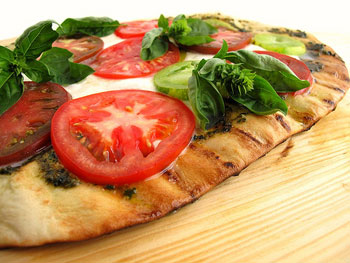From the LA Times
 I've just discovered the magic of fresh bread crumbs. You might say it's about time, after 30 years of cooking. But I would remind you that I said the "magic" of fresh bread crumbs, not the "utility."
I've just discovered the magic of fresh bread crumbs. You might say it's about time, after 30 years of cooking. But I would remind you that I said the "magic" of fresh bread crumbs, not the "utility."
Everyone knows about using bread crumbs for coating a schnitzel or any other fried, baked or broiled thing. Or stuffing a bird or whole fish. Or scattering across the top of a gratin or tian before browning. I've even used them as toppings for fruit desserts, like a less-sweet version of a crisp.
But what I'd never really realized was the true potential of bread crumbs, how instead of being bland character actors toiling in the background, they can actually become the stars of a dish, or at least a very impressive second lead.
Top steamed or braised vegetables with some carefully toasted bread crumbs and the dish is transformed by the infusion of crunch and that golden brown flavor.

 I love making pizza, not just because it's fun, but also because I think mine can rival any pizza parlor's. I have the entire set-up, including a pizza stone and peel. But this time I put all that aside to try something new. Instead of the typical way of baking pizza, have you ever tried grilling it? For years I've been told that grilled pizza is the best, but I haven't actually done it myself until now. I was pleasantly surprised and impressed by the outcome.
I love making pizza, not just because it's fun, but also because I think mine can rival any pizza parlor's. I have the entire set-up, including a pizza stone and peel. But this time I put all that aside to try something new. Instead of the typical way of baking pizza, have you ever tried grilling it? For years I've been told that grilled pizza is the best, but I haven't actually done it myself until now. I was pleasantly surprised and impressed by the outcome. I didn't really think much about food and what went into making a nice meal until I was somewhat forced to learn how to cook when I was laid off (again) about ten years ago. I needed something to do with my free time and felt like I should contribute something to the household, since I was no longer bringing in any dough, so to speak. While I had certainly thrown things together over the years, this was a new quest to eat better and see if time and effort really made a difference.
I didn't really think much about food and what went into making a nice meal until I was somewhat forced to learn how to cook when I was laid off (again) about ten years ago. I needed something to do with my free time and felt like I should contribute something to the household, since I was no longer bringing in any dough, so to speak. While I had certainly thrown things together over the years, this was a new quest to eat better and see if time and effort really made a difference. Now, I generally steer clear of plastic cooking tools that look like the crap sold on tv at 3:00 am. It dices! It slices! Hey, guess what? I do too! But a client of mine had ripped a page from her Williams Sonoma catalog with a picture of a vegetable extruder and I was intrigued. I did some investigating and found one a little cheaper on Amazon made by Bitoni with the magic words… lifetime replacement warranty. Now we’re talkin’.
Now, I generally steer clear of plastic cooking tools that look like the crap sold on tv at 3:00 am. It dices! It slices! Hey, guess what? I do too! But a client of mine had ripped a page from her Williams Sonoma catalog with a picture of a vegetable extruder and I was intrigued. I did some investigating and found one a little cheaper on Amazon made by Bitoni with the magic words… lifetime replacement warranty. Now we’re talkin’. It was in the early to mid-80s and I was about 10-11 years old. When we went to the supermarket, I would always have my parents buy me the little Pillsbury cookbooks that were in the check-out line. I remember one specific of the cookbook series because I made every single recipe in it, including a chocolate pudding pie. I crushed up chocolate Nabisco wafers, made a crust, poured in instant pudding and topped it with some sort of doctored-up Cool-Whip.
It was in the early to mid-80s and I was about 10-11 years old. When we went to the supermarket, I would always have my parents buy me the little Pillsbury cookbooks that were in the check-out line. I remember one specific of the cookbook series because I made every single recipe in it, including a chocolate pudding pie. I crushed up chocolate Nabisco wafers, made a crust, poured in instant pudding and topped it with some sort of doctored-up Cool-Whip.